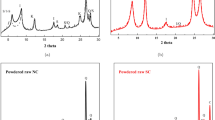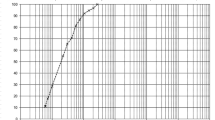Abstract
Soft clay deposits are highly plastic, normally consolidated fine grained soils characterized by their low inherent shear strength. The mixing of soft clays with cement as a chemical stabilizer has become a well-known stabilization technique. The resulting strength of the clay–cement mix is controlled by different factors, but mainly the water to cement ratio, the cement content, and the curing conditions. It is crucial to develop a clear understanding of the changes in engineering behavior of the clay–cement mix that result from changes in controlling factors. A phase diagram was established to define the initial conditions of the mass–volume relationships of air, cement, clay, and water of a typical clay–cement mix. This phase diagram was then used to determine the total dry density, void ratio, and specific gravity of the clay–cement mix as a function of the cement content and water to cement ratio. The main objective of this work was to develop generalized trends for the geotechnical properties of clay–cement mixes. These trends were evaluated based on unconfined compressive strength as well as consistency tests carried out on soft clay samples before and after mixing with cement and at different curing times. A reduction in the plasticity index (PI) of 16 % and an increase in the unconfined shear strength of more than 200 kPa were obtained from the addition of 15 % cement. The reduction in the PI of the clay–cement mix was found to be an efficient tool to represent the improvement in the strength of the clay after mixing with cement.






Similar content being viewed by others
References
AASHTO, FHWA (2003) Scanning project innovative technology for accelerated construction of bridge and embankment foundation in Europe. Report no. FHWA-PL-03-014. U.S. Department of Transportation, Federal Highway Administration, Washington, DC
Al-Tabbaa A, Evans WC (1998) Pilot in situ auger mixing treatment of a contaminated site-Part 1: treatability study. In: Proc the Institution of Civil Engineers—Geotechnical Engineering, No 131, Jan 1998, pp 52–59
ASTM (2006) Standard test method for unconfined compressive strength of cohesive soils. Practice no. D2166-06. ASTM, West Conshohocken
Austroads (1998) Guide to stabilization in road works. Publication No. AP-60/98. Austroads, Sydney
Bergado DT, Anderson LR, Miura N, Balasubramaniam AS (1996) Improvement of soft ground in lowland and other environments. ASCE, Reston, p 427
Bowles JE (1996) Foundation analysis and design, 5th edn. McGraw-Hill, New York
Chen FH, Morris MD (2000) Soil engineering: testing, design and remediation. CRC, Boca Raton, p 288
Chen H, Wang Q (2006) The behavior of organic matter in the process of soft soil stabilization using cement. Bull Eng Geol Environ 65(4):445–448
Den Haan EJ (2000) Laboratory preparation of test samples of soil stabilized by cement-type materials (Chapter 6). In: Eurosoilstab Design Guide. Report no. 393220/6. GeoDelft, Gouda
Esrig MI (1999) Keynote lecture: properties of binders and stabilized soil. In: Brendenberg H, Broms BB, Holm G (eds) Dry mix methods for deep soil stabilisation. Balkema, Rotterdam, pp 67–72
EuroSoilStab (2002) Design guide: soft soil stabilization-development of design and construction methods to stabilise soft organic soils. CT97-0351, project no. BE-96-3177. European Commission, Brussels
FHWA (1998) Ground improvement technical summaries. Report no. FHWA-SA-98-086. Federal Highway Administration, Washington, DC
Grimstad G, Degado S, Nordal S, Karstunen M (2010) Modeling creep and rate effects in structured anisotropic soft clays. Acta Geotech 5(1):69–81
Gue SS, Tan YC (2000) Subsurface investigation and interpretation of test results for foundation design in soft clay. Seminar on ground improvement—soft clay. UTM, Kuala Lumpur
Hassan M (2009) Engineering characteristics of cement stabilized soft Finnish clays—a laboratory study. Licentiate’s thesis. Helsinki University of Technology, Helsinki
Ho M, Chan C (2011) Some mechanical properties of cement stabilized Malaysian soft clay. World Acad Sci Eng Technol 74:24–31
Horpibulsk S, Rachan R, Suddeepong A, Chinkulkijniwat A (2011) Strength development in cement admixed Bangkok clay: laboratory and field investigations. Soil Found 51(2):239–251
Jacobson J (2002) Factors affecting strength gain in lime-cement columns and development of a laboratory testing procedure. Masters thesis. Virginia Polytechnic Institute and State University, Blacksburg
Jaritngam S, Swasdi S (2006) Improvement for soft soil by soil-cement mixing. In: Proc 4th Int Conf on Soft Soil Engineering, Vancouver, Canada, 4–6 Oct 2006, pp 637–640
Kamruzzaman MHA, Chew HS, Lee HF (2000) Engineering behaviour of cement treated singapore marine clay. In: Proc Int Conf on Geotechnical and Geological Engineering, Melbourne, Australia, 19–24 Nov 2000, pp 19–24
Kawasaki T, Niina A, Saitoh S, Suzuki Y, Honjyo Y (1981) Deep mixing method using cement hardening agent. In: Proc 10th Int Conf on Soil Mechanics and Foundation Engineering, Stockholm, Sweden, 15–19 June 1981, pp 721–724
Kezdi A (1979) Stabilization with lime. Developments in Geotechnical Engineering, vol 19. Elsevier, Amsterdam, pp 163–174
Maher A, Bennert T, Jafari F, Douglas WS, Gucunski N (2004) Geotechnical properties of stabilized dredged material from New York–New Jersey Harbor. J Transp Res Board 1874:86–96
Miura N, Horpibulsuk S, Nagaraj TS (2001) Engineering behavior of cement stabilized clay at high water content. Soils Found Jpn Geotech Soc 41(5):33
Oh EYN (2007) Geotechnical and ground improvement aspects of motorway embankments in soft clay. PhD dissertation. Griffith University, Gold Coast/Brisbane
PCA (2003) Properties and uses of cement-modified soil. Portland Cement Association, Skokie
Porbaha A, Shibuya S, Kishida T (2000) State of the art in deep mixing technology. Ground Improv 4(3):91–110
Rafalko S (2006) Rapid soil stabilization of soft clay soils for contingency airfields. Masters thesis. Department of Civil and Environmental Engineering, Virginia Polytechnic Institute and State University, Blacksburg
Saadeldin R, Siddiqua S (2013) Evaluation of strength development in a clay–cement mix. In: GeoMontreal 2013, Montreal, Canada, 29 Sept–3 Oct 2013
Saadeldin R, Salem M, Lotfi HA (2011) Performance of road embankment on cement stabilized soft clay. In: Proc 64th Canadian Geotechnical Conf and 14th Pan-American Conf on Soil Mechanics and Geotechnical Engineering, Toronto, Canada, 2–6 Oct 2011 (CD ROM)
Saitoh S, Suzuki Y, Shirai K (1985) Hardening of soil improvement by deep mixing method. In: Proc 11th Int Conf on Soil Mechanics and Foundation Engineering, San Francisco, CA, USA, 12–16 Aug 1985, pp 947–950
Saitoh S, Nishioka S, Suzuki Y, Okumura R (1996) Required strength of cement improved ground. In: Proc 2nd Int Conf on Ground Improvement, Geosystems and Grouting and Deep Mixing, Tokyo, Japan, 14–17 May 1996, pp 481–484
Sherwood P (1993) Soil stabilization with cement and lime. State of the art review. Transport Research Laboratory, HMSO, London
Solanki P, Zaman M (2012) Microstructural and mineralogical characterization of clay stabilized using calcium-based stabilizers. Scanning Electron Microsc 38:771–798, ISBN: 978-953-51-0092-8
Taki O, Yang D (1991) Soil cement mixed wall technique. ASCE Spec Publ (27):298–203
Uddin K, Balasubramaniam AS, Bergado DT (1997) Engineering behavior of cement-treated Bangkok soft clay. Geotech Eng-SEAGS 28(1):89–119
White WG, Gnanendran CT (2005) The influence of compaction method and density on the strength and modulus of cementitiously stabilized pavement material. Int J Pavement Eng 6(2):97–110
Xiao HW, Lee FH (2008) Curing time effect on behavior of cement treated marine clay. Proc World Acad Sci Eng Technol 33:71–78
Acknowledgments
The authors would like to acknowledge the contribution of Dr. Hani Lotfi and Dr. Manal A. Salem of Geotechnical Engineering, Cairo University, and thank them for their great support during the course of obtaining some of the results presented in this paper.
Author information
Authors and Affiliations
Corresponding author
Rights and permissions
About this article
Cite this article
Saadeldin, R., Siddiqua, S. Geotechnical characterization of a clay–cement mix. Bull Eng Geol Environ 72, 601–608 (2013). https://doi.org/10.1007/s10064-013-0531-2
Received:
Accepted:
Published:
Issue Date:
DOI: https://doi.org/10.1007/s10064-013-0531-2




